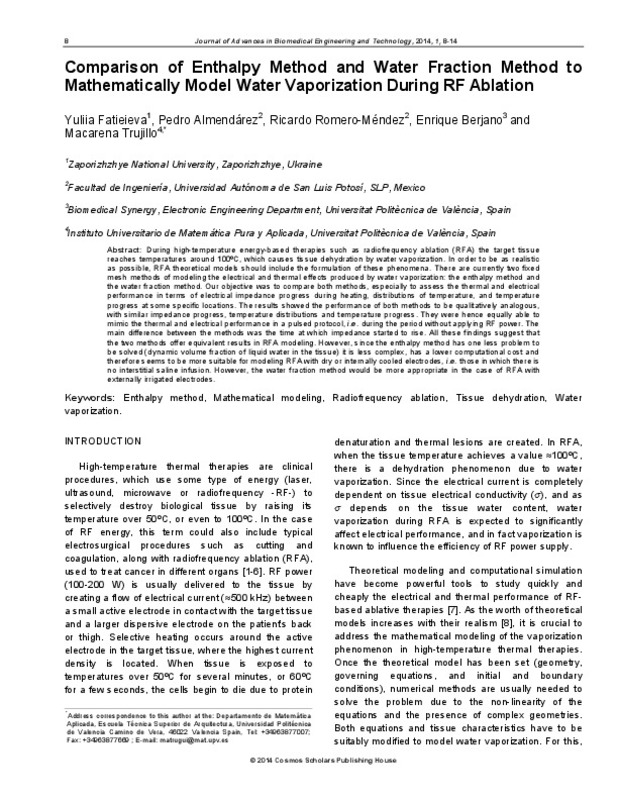JavaScript is disabled for your browser. Some features of this site may not work without it.
Buscar en RiuNet
Listar
Mi cuenta
Estadísticas
Ayuda RiuNet
Admin. UPV
Comparison of enthalpy method and water fraction method to mathematically model water vaporization during RF ablation
Mostrar el registro sencillo del ítem
Ficheros en el ítem
| dc.contributor.author | Fatieieva, Yuliia
|
es_ES |
| dc.contributor.author | Almendárez, Pedro
|
es_ES |
| dc.contributor.author | Romero-Méndez, Ricardo
|
es_ES |
| dc.contributor.author | Berjano, Enrique
|
es_ES |
| dc.contributor.author | Trujillo Guillen, Macarena
|
es_ES |
| dc.date.accessioned | 2017-07-14T14:35:08Z | |
| dc.date.available | 2017-07-14T14:35:08Z | |
| dc.date.issued | 2014-09 | |
| dc.identifier.issn | 2409-3394 | |
| dc.identifier.uri | http://hdl.handle.net/10251/85168 | |
| dc.description.abstract | [EN] During high-temperature energy-based therapies such as radiofrequency ablation (RFA) the target tissue reaches temperatures around 100ºC, which causes tissue dehydration by water vaporization. In order to be as realistic as possible, RFA theoretical models should include the formulation of these phenomena. There are currently two fixed mesh methods of modeling the electrical and thermal effects produced by water vaporization: the enthalpy method and the water fraction method. Our objective was to compare both methods, especially to assess the thermal and electrical performance in terms of electrical impedance progress during heating, distributions of temperature, and temperature progress at some specific locations. The results showed the performance of both methods to be qualitatively analogous, with similar impedance progress, temperature distributions and temperature progress. They were hence equally able to mimic the thermal and electrical performance in a pulsed protocol, i.e. during the period without applying RF power. The main difference between the methods was the time at which impedance started to rise. All these findings suggest that the two methods offer equivalent results in RFA modeling. However, since the enthalpy method has one less problem to be solved (dynamic volume fraction of liquid water in the tissue) it is less complex, has a lower computational cost and therefore seems to be more suitable for modeling RFA with dry or internally cooled electrodes, i.e. those in which there is no interstitial saline infusion. However, the water fraction method would be more appropriate in the case of RFA with externally irrigated electrodes. | es_ES |
| dc.description.sponsorship | This work received financial support from the Spanish “Plan Nacional de I+D+I del Ministerio de Ciencia e Innovación” Grant No. TEC2011-27133-C02-01. | |
| dc.language | Inglés | es_ES |
| dc.publisher | Cosmos Scholars Publishing House | es_ES |
| dc.relation.ispartof | Journal of Advances in Biomedical Engineering and Technology | es_ES |
| dc.rights | Reconocimiento - No comercial (by-nc) | es_ES |
| dc.subject | Enthalpy method | es_ES |
| dc.subject | Mathematical modeling | es_ES |
| dc.subject | Radiofrequency ablation | es_ES |
| dc.subject | Tissue dehydration | es_ES |
| dc.subject | Water vaporization | es_ES |
| dc.subject.classification | MATEMATICA APLICADA | es_ES |
| dc.subject.classification | TECNOLOGIA ELECTRONICA | es_ES |
| dc.title | Comparison of enthalpy method and water fraction method to mathematically model water vaporization during RF ablation | es_ES |
| dc.type | Artículo | es_ES |
| dc.identifier.doi | 10.15379/2409-3394.2014.01.01.2 | |
| dc.relation.projectID | info:eu-repo/grantAgreement/MICINN//TEC2011-27133-C02-01/ES/MODELADO TEORICO Y EXPERIMENTACION PARA TECNICAS ABLATIVAS BASADAS EN ENERGIAS/ | es_ES |
| dc.rights.accessRights | Abierto | es_ES |
| dc.contributor.affiliation | Universitat Politècnica de València. Departamento de Ingeniería Electrónica - Departament d'Enginyeria Electrònica | es_ES |
| dc.contributor.affiliation | Universitat Politècnica de València. Instituto Universitario de Matemática Pura y Aplicada - Institut Universitari de Matemàtica Pura i Aplicada | es_ES |
| dc.contributor.affiliation | Universitat Politècnica de València. Departamento de Matemática Aplicada - Departament de Matemàtica Aplicada | es_ES |
| dc.description.bibliographicCitation | Fatieieva, Y.; Almendárez, P.; Romero-Méndez, R.; Berjano, E.; Trujillo Guillen, M. (2014). Comparison of enthalpy method and water fraction method to mathematically model water vaporization during RF ablation. Journal of Advances in Biomedical Engineering and Technology. 1(1):8-14. https://doi.org/10.15379/2409-3394.2014.01.01.2 | es_ES |
| dc.description.accrualMethod | S | es_ES |
| dc.relation.publisherversion | http://dx.doi.org/10.15379/2409-3394.2014.01.01.2 | es_ES |
| dc.description.upvformatpinicio | 8 | es_ES |
| dc.description.upvformatpfin | 14 | es_ES |
| dc.type.version | info:eu-repo/semantics/publishedVersion | es_ES |
| dc.description.volume | 1 | es_ES |
| dc.description.issue | 1 | es_ES |
| dc.relation.senia | 276474 | es_ES |
| dc.contributor.funder | Ministerio de Ciencia e Innovación |








